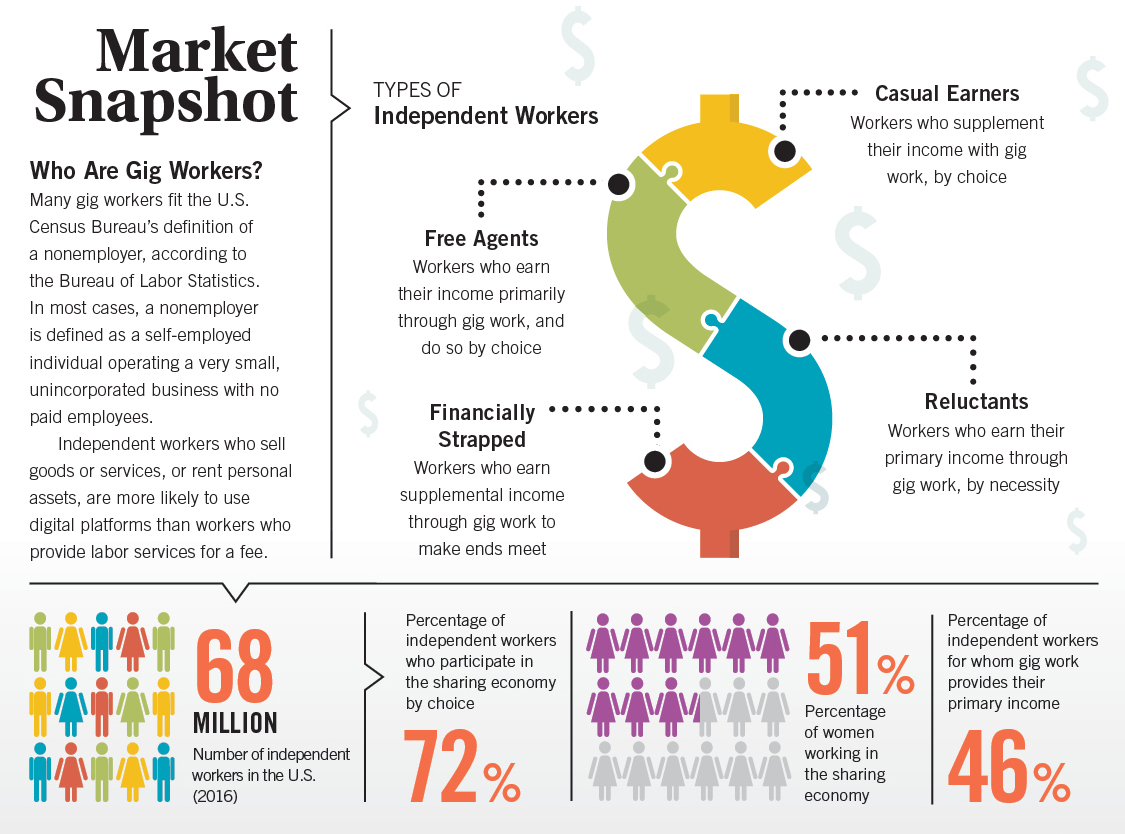Market To Market: Share And Share Alike

As competition for a spot in the traditional workplace heats up, the desire to punch a clock at someone else’s whim is cooling off. The rising popularity of a sharing economy—or gig economy—increasingly appeals to individuals who aim to make a living off their skills, services and even creative talents, in a manner of their own choosing.
A McKinsey Global Institute study released in October 2016, Independent Work: Choice, Necessity And The Gig Economy, found this market employs nearly 68 million people in the U.S. and approximately 92 million across the European Union. Of the 8,000 workers surveyed, 44 percent work in the gig economy as a primary source of employment, while 56 percent use this market to supplement their primary income from traditional jobs.
The defining features of sharing economy employment (independent workers) are a high level of control and autonomy; payment by task, assignment or sales volume and a short-term duration/relationship with clients.
High-profile gig economy players include Airbnb, Uber and Lyft. But other up-and-comers such as taskrabbit, a service platform that allows users to hire workers for everyday tasks, and NeighborGoods, which allows individuals to “share” their household goods and tools with one another, branch out with their offerings of goods and services.
The gig economy’s roots are firmly planted in the entrepreneurship that dominated the early 20th century, but the primary difference between independent business operators and gig workers, according to the McKinsey study, is that the latter primarily focus on short-term commitments to several clients, rather than building long-term relationships with individual ones.
And while workers in the sharing economy benefit from flexibility and variety, the flip side is the likelihood of inconsistency, along with the challenge of obtaining and affording insurance coverage.
When a book of business is built primarily with one-time transactions, self promotion can be the best means of securing a steady stream of clients—and income. Gig workers benefit from self promotions that zero in on target audiences and tell prospects that their satisfaction is the service provider’s top priority.

---
Case Studies
Holiday Helpers
The holidays are as much about managing stress as they are about celebrating the season, which distributor Axis Promotions recognizes. To help clients relax and keep the company top of mind during the busy season, Axis created a kit of useful promotional items that were paired with a clever tagline and sent it to 1,000 customers.
The kit included an adult coloring book with tip-in pages citing the benefits of adult coloring, and colored pencils; a life-size ceramic hand-shaped pencil cup with a magnetic side to hold paper clips; a Belgian chocolate candy bar, and a custom box in which to display and ship the items.
The clients who received the kits shared their enthusiasm with Axis. As a result of the campaign, Axis garnered roughly $200,000 in sales from new and longtime clients, as well as invitations to participate in three requests for proposals (RFPs). The campaign also was honored with a Gold PPAI Image Award in 2017.
Source: Axis Promotion
Inking Impressions
Portability and permanence are among the desirable traits sought in an effective promotional product. Supplier All In One was looking for a unique self promotion that incorporated these elements while also bringing attention to a new product, the USA FoldzFlat Pen. Doubling as a business card, the pen was distributed to hundreds of distributor contacts at trade shows and meetings, and through mailings (the fold-flat design makes the pen ideal for direct mail).
The ‘wow’ factor of the pen, along with its USA-made appeal, increased name and face recognition for sales reps who gave the pens to their distributor contacts, some of whom used the pen in their own self-promotion efforts.
Source: All-In-One
---
For individual products, please visit our flipbook.
Jen Alexander is associate editor of PPB.

